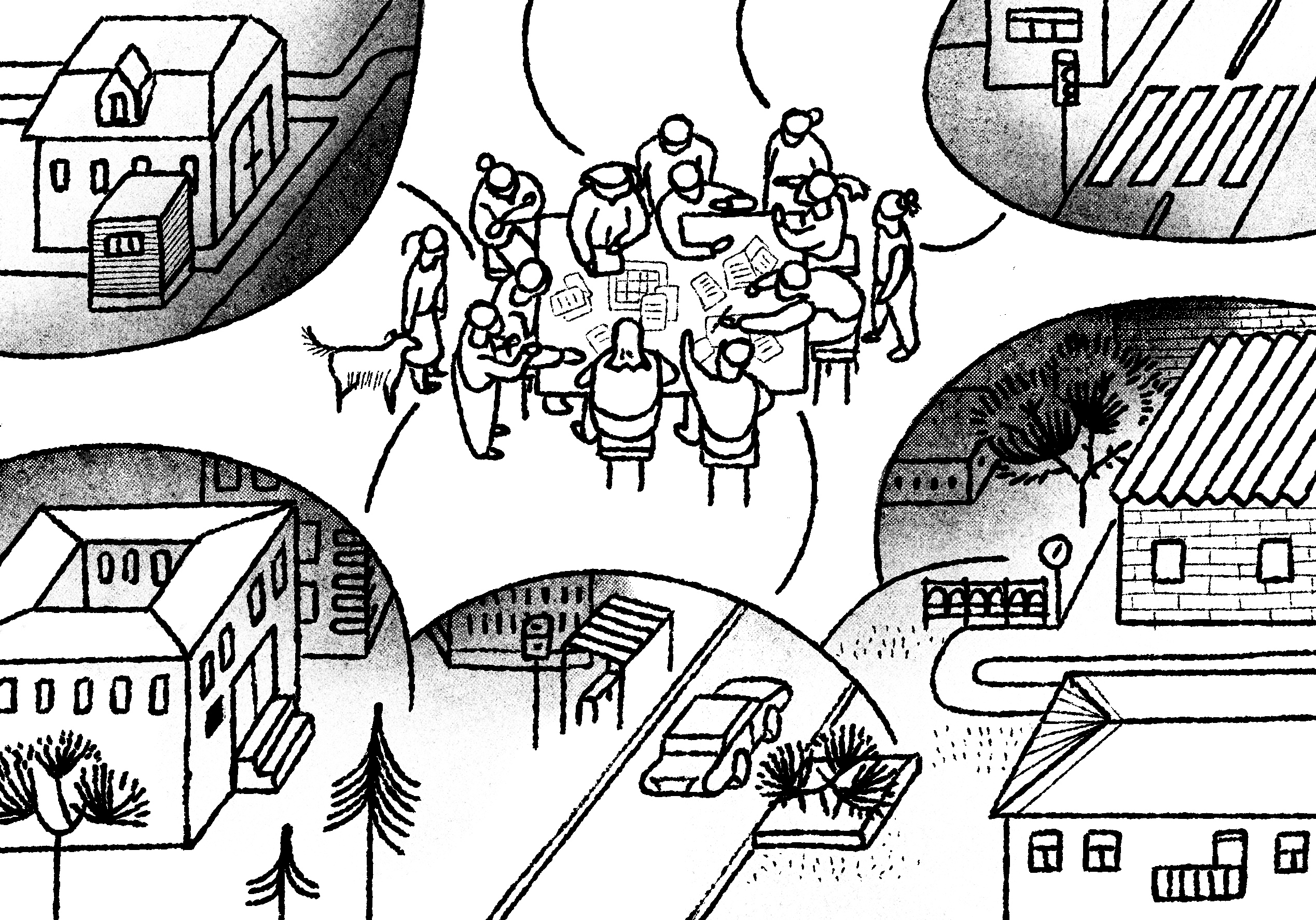
Introduction
As a part of the project No-One Left Behind: Public Participation in Hromadas Recovery Planning, Cedos Think Tank offered ten territorial hromadas help with the participatory planning of their recovery, development, and search for solutions to the current challenges. The hromadas that participated in the project were selected among 71 applications as a part of an open competition which was held in March 2023.
The project’s goal was to strengthen the hromadas’ capacity to engage their residents in the process of recovery with the aim to overcome the consequences of the war and the challenges caused by it.
As part of the project, in May–October 2023, the selected hromadas worked with teams of experts in the fields of citizen engagement, research, spatial and strategic development, working with heritage, education, social protection, housing, and urban planning.
The project involved collective work by the experts together with the hromadas on the following steps:
- evaluating the hromada’s need for engaging residents in the implementation of a specific project (program, strategy) which the hromada had been working on or planned to work on;
- determining the key challenges and limitations related to resident engagement;
- developing a plan for the engagement of residents and other stakeholders in the development and implementation of the project (program, strategy);
- conducting one resident engagement event.
In addition, the experts provided brief recommendations on how to establish the participation process and engage residents in each hromada.
This document presents the key results of the cooperation of the engagement experts with the 10 selected hromadas, particularly conclusions regarding the collective work with hromada representatives and recommendations on establishing participatory processes.
All annexes to this report can be found in the document via the link (in Ukrainian).
Bilokurakyne Hromada, Luhansk Region
About the hromada
- Hromada’s type: rural town
- Population: 15,005 people as of January 1, 2022
- Area: 789,5 km²
- Year of merging: 2015
The hromada consists of one rural town, Bilokurakyne, and 37 villages. Before the beginning of the full-scale invasion, the hromada’s economy mostly focused on agriculture. In March 2022, the hromada was completely occupied by Russia, so the majority of the population and local government bodies were forced to move to other regions.
Engagement request
The hromada’s local self-government bodies support the internally displaced population both from the Bilokurakyne hromada and from the entire Luhansk Region. In order to support their population, the hromada founded the Council of Internally Displaced People in April 2023 and drafted the Complex Program for Supporting IDPs. The hromada also founded a Coordination Center to support IDPs from the Luhansk Region who had moved to the Zhytomyr Region.
The hromada’s requests concerned these areas of work. Hromada’s representatives needed to establish the work of the IDP Council and update the Compex Program for Supporting IDPs. They also needed to assess the employment needs and the interest in collective leisure among the visitors of the Coordination Center.
Working with the hromada
Discussing the request and planning further work on the engagement of hromada’s residents. The experts began their work with the hromada by clarifying the request and the goal which the hromada wanted to achieve. In addition, they organized a discussion of the local government’s previous experience of engagement and the difficulties they had faced. During the discussion, the engagement experts outlined the areas of the joint work:
- conducting a survey among the visitors of the Coordination Center;
- organizing a strategic session for the IDP Council;
- improving the hromada’s communication skills.
Public communication training. One of the hromada’s key problems with engagement was communication with the residents. Engagement experts analyzed the hromada’s communication on its social media pages, website, and news resources. This analysis served as a basis for drafting a number of recommendations on how to improve the effectiveness of communication with the audience. The experts also conducted a training session where they discussed:
- how to publicly cover the work of local self-government bodies (LSGBs) on the website, social media and messenger channels;
- how to engage the hromada in online discussions;
- how to participate in citizen-initiated discussions of the work of LSGBs;
- how to work with negative comments in the public space.
Survey. One of the tasks of the Coordination Center as a part of supporting IDPs from the Luhansk Region, according to the hromada, was to help IDPs find employment in the Zhytomyr Region. Therefore, together with the local government, engagement experts designed a questionnaire for conducting a quantitative survey. The questions in the questionnaire were related to employment needs, the respondents’ qualifications, and their willingness to re-train. The hromada saw the need to increase the social cohesion of IDPs from the Luhansk Region, so the second block of the survey was dedicated to the interest in shared leisure. The survey was held both online and in the paper format. As part of the process of drafting the questionnaire, the experts conducted training in the use of Google Forms for conducting surveys.
Strategic session for the IDP council. The hromada’s IDP Council was formed in April 2023, and only one Council session had been held by the time the experts’ work with the hromada began. So there was a need to organize the Council’s work and draft a plan for its further activities. In order to do this, the engagement experts, together with the hromada, organized a strategic session where they worked out the following questions:
- What will need to be done to return to the hromada after its de-occupation?
- What areas of this work are of the highest priority?
- What is the plan for working in these areas: what needs to be done now, and what will need to be done immediately upon returning?
- What are the most urgent needs of IDPs, what programs, projects, ideas will be useful while organizing help for them?
- What are the IDP Council’s training needs?
- What is the plan of action for the next two weeks?
As a result of the session, information was obtained that was required to update the Complex Program for Supporting IDPs.
Key outcomes of working with the hromada
The project experts successfully managed to:
- clarify the urgent needs of idps and the ways to meet these needs, and to draft a plan for the hromada’s further work in helping IDPs, namely a list of the required tactical steps for the nearest period and of the strategic areas of work;
- organize the beginning of cooperation between the local self-government bodies and the IDP Council: after the strategic session, LSGB representatives conducted several training and leisure events for IDPs;
- activate the work of the IDP Council: after the strategic session, the IDP Council continued to work actively and conducted several meetings to draft the working plan for the next 2 years;
- work out, in collaboration with the hromada, the key rules of communication with the hromada’s residents on social media and other digital channels, particularly the rules of dialogue and response to negative comments from residents;
- collect data on IDP needs for employment and re-training, and their interest in shared leisure; based on the collected information, the local self-government bodies are organizing events at the Coordination Center to support IDPs from the Luhansk Region, particularly training events in collaboration with the Employment Center, and redirect people who are interested in volunteering to the relevant centers in the Zhytomyr Region.
Challenges while working with the hromada
It was somewhat more difficult to collect answers in the survey. IDPs’ response to the request to fill out the form was lower than expected. These difficulties can be overcome by using the snowball method to spread the questionnaire among IDPs. It can also be helpful to regularly share reminders about the survey on the hromada’s communication platforms. In addition, one possible way to increase the response can be an offline survey with a paper questionnaire in locations where IDPs gather.
Annex 1. Questionnaire for IDPs from the Luhansk Region who have moved to the Zhytomyr Region
Bila Tserkva Hromada, Kyiv Region
About the hromada
- Hromada’s type: urban
- Population: about 220,500 people as of 2023
- Area: 395 km²
- Year of merging: 2020
The hromada consists of the city of Bila Tserkva, the town of Terezyne and 15 villages. The hromada is located in the south of the Kyiv Region, and the distance from the hromada’s center, Bila Tserkva, to Kyiv is about 80 kilometers along the Kyiv-Odesa Highway. Its convenient transportation connection along with its natural areas, particularly the River Ros and the Oleksandria Arboretum, make the city attractive for residence and tourism. The hromada’s economic development, among other things, involves the existence of quite a few industrial facilities, such as the Rosava Tire Factory, Bila Tserkva Reinforced Concrete Structures Factory, Bila Tserkva Dairy Factory, Biopharma Factory, and over 50 others. In addition, there is an industrial park in the hromada. The hromada also has 16 education institutions, particularly the Bila Tserkva National Agrarian University.
Engagement request
The hromada requested help with engaging the local youth to collect their ideas and “dreams” about the hromada’s future development, which LSGBs would like to use as the basis for working on the Hromada’s Development Strategy until 2032 (hereafter referred to as the Strategy), which was planned to be created by the 1000th anniversary since the founding of Bila Tserkva. The hromada’s representatives also had a request to involve project experts as intermediaries between the youth and local self-government bodies in order to build trust between them.
Working with the hromada
After clarifying the request and examining the context of the Strategy’s development, the engagement experts planned and participated in the activities described below.
Workshop to analyze the stakeholders of the Strategy. During the first visit to the hromada in July 2023, a two-day workshop was held in the building of the Bila Tserkva Strategic Development Agency where representatives of LSGBs, including councilors and the mayor’s deputies, learned how to determine and map stakeholders, analyze opportunities and approaches to interacting with them. In addition to youth, several other categories of stakeholders were determined and then added to the map of influence and interest.
Development of a questionnaire to collect the suggestions or “dreams” of young people in the hromada. In the second half of August 2023, several online workshops were conducted with the initiative group to develop and test the questionnaire. The collection of suggestions using the online questionnaire covered a large number of young people, including young people from the rural area. The Google Form survey helped collect over 400 suggestions during September–October 2023.
Strategic session involving young people. On September 19, 2023, a Strategic Session was held in the building of the Youth Center in Bila Tserkva, involving about 30 representatives of youth organizations, clubs, and students. The event participants worked in several formats:
- plenary: the mayor presented the idea for developing the Strategy;
- group: emotions mapping — the participants were offered to mark locations on the map which make them feel fear, sadness, joy, or interest, and present the results to the other participants; a World Cafe with four discussion tables:
- places that are hromada’s magnets;
- places with potential for strengthening;
- the hromada’s unique strengths;
- processes that should work differently.
The event was followed by feedback on how to activate the potential of the youth, how to engage the hromada’s rural residents and interact with them, and how to strengthen Bila Tserkva’s brand.
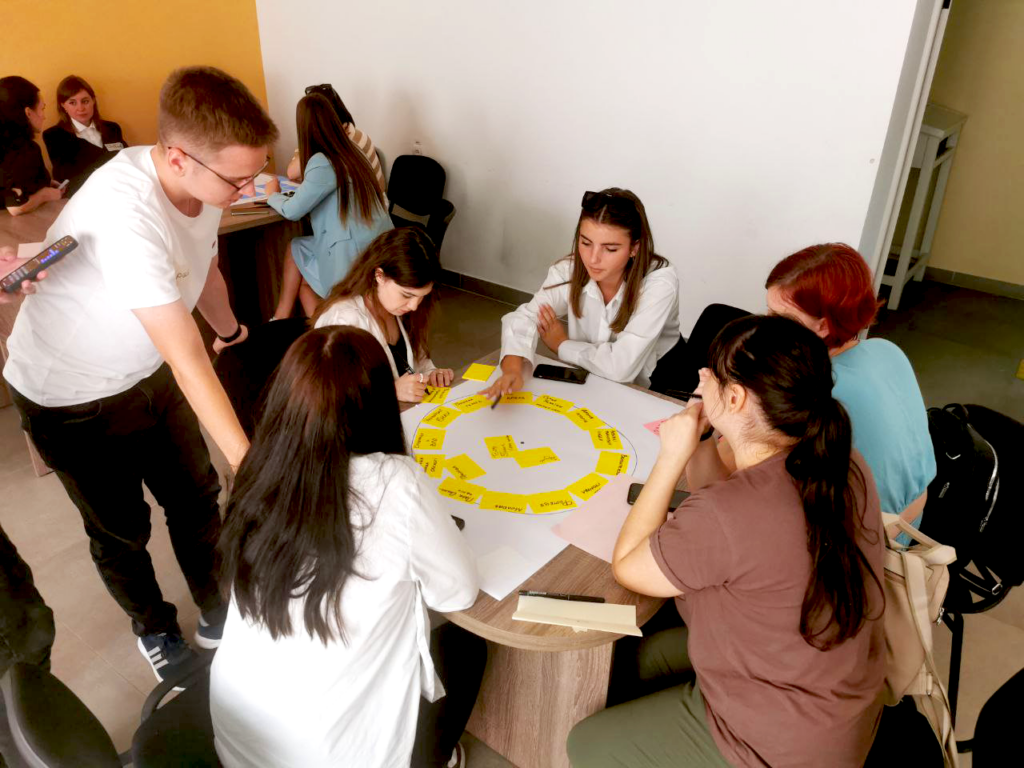
Key outcomes of working with the hromada
- the young people invited to the Strategic Session were motivated and interested in the discussions, they were active in the group work during the event;
- LSGB representatives invited journalists to the strategic session to cover the event in the media;
- the participants marked locations which required attention on a map, so it will be convenient for LSGB representatives to process the results afterwards.
Challenges while working with the hromada
The team failed to engage the planned number of young people from the rural area and young people who are not members of student unions or other active associations. In addition, they did not manage to engage the planned number of representatives of certain groups of young people, particularly young parents, young people with disabilities, and young people with mobility issues. This can be remedied by organizing focus groups with these categories of young people.
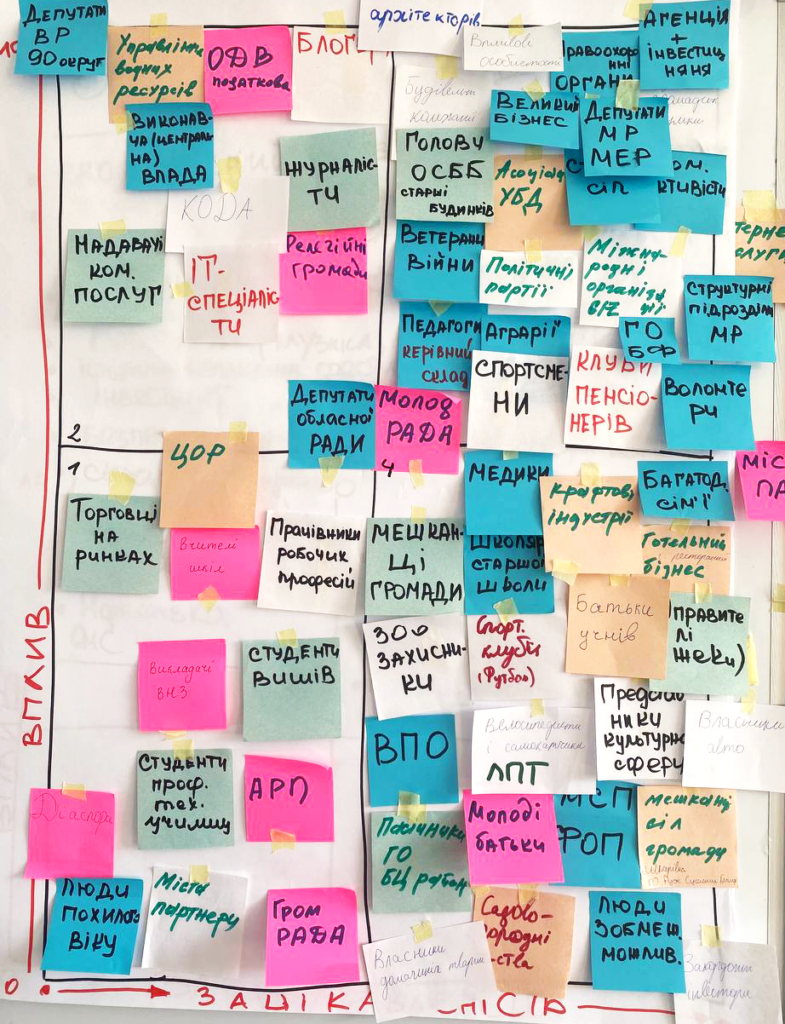
Annex 2. Questionnaire for the youth of the Bila Tserkva Hromada
Valky Hromada, Kharkiv Region
About the hromada
- Hromada’s type: urban
- Population: 30,435 people as of 2021
- Area: 1019,0 km²
- Year of merging: 2020
The hromada includes one city of Valky (hromada’s center), two urban towns, and 99 villages. The hromada’s specialization is agrarian, and companies are mostly focused on agriculture. According to the hromada’s data, its population was 51,400 people as of December 2022—it grew due to the arrival of internally displaced people.
Engagement request
At the time of the beginning of cooperation, the team had a detailed draft of its Development Strategy (hereafter referred to as the Strategy). However, as a result of the full-scale invasion, the hromada was in a highly uncertain situation for a long time. Due to the war, its population, statistics, and planning priorities were changing rapidly. So representatives of the hromada requested help with collecting the needs of the population in order to update the Strategy document.
Working with the hromada
Discussing the hromada’s request and working with stakeholders. The work with the hromada began by clarifying the request, learning about their previous experience of organizing participation and with the difficulties they had faced, and analyzing the draft Strategy that had been developed by then. Engagement experts also mapped the stakeholders, and the hromada chose young people as the priority group for engagement. So at the first stage, the team clarified the request with a focus on an in-depth understanding of current expectations, priorities, and challenges for the hromada’s youth.
Analyzing the hromada’s communications in the public space. The hromada shared their concerns about the difficulties they had in communicating with the population, the existence of a lot of negative feedback about the government’s activities, and the population’s low interest in news about hromada’s development. Engagement experts analyzed the social media pages where local self-government bodies published hromada’s news as well as open groups created by hromada’s residents to openly discuss the work of LSGBs. In order to help the hromada establish communication with the population, teach them to work with negative comments, and improve their skills of communicating their work in an accessible manner, the engagement experts conducted a public communication training.
Event to engage the youth. The event was attended by about 25 participants, including representatives of the school youth parliament, youth NGOs, and active youth. During the discussion, the young people discussed the following questions:
- What does a place you want to live in look like, and what is in it? How does everything work there? What happens there and what is possible?
- What good things already exist in the Valky Hromada?
- What initiatives and projects will help bring the hromada closer to the picture of the desired future?
- What can we do already next week to start doing it?
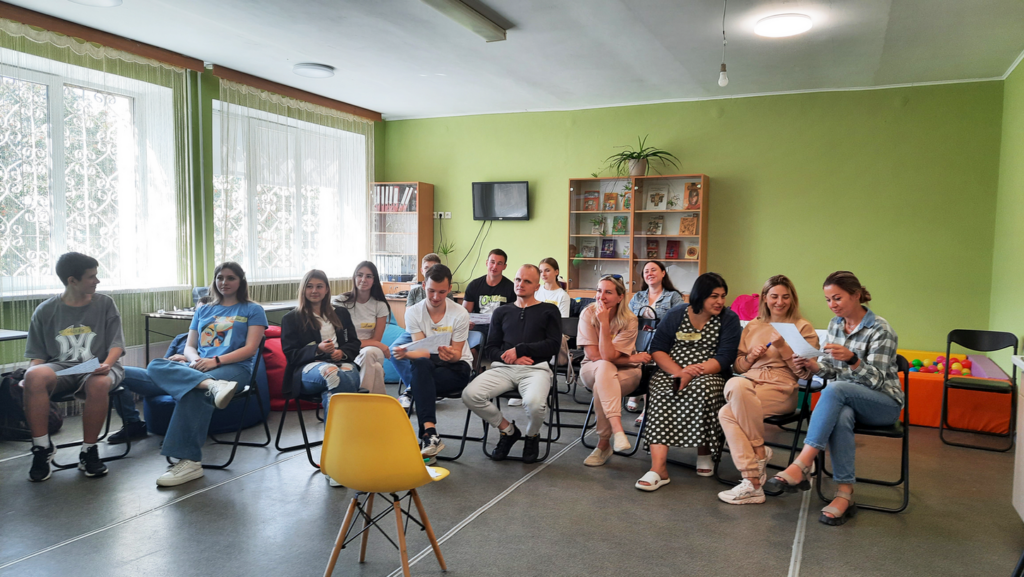
Key outcomes of working with the hromada
The project experts successfully managed to:
- engage active youth and introduce them to one another, create a space for exchanging opinions and views on the hromada’s development; demonstrate that they have many things in common; develop ideas for collective projects and allow them to exchange contacts; communicate that local self-government bodies are open to communication and to implementing the ideas of young people;
- clarify the main needs of young people and their vision of the future of the Valky Hromada;
- conduct a public communications training, improve the hromada’s skills in publicizing their work, responding to negative comments, participating in hromada-initiated discussions of the work of local government bodies.
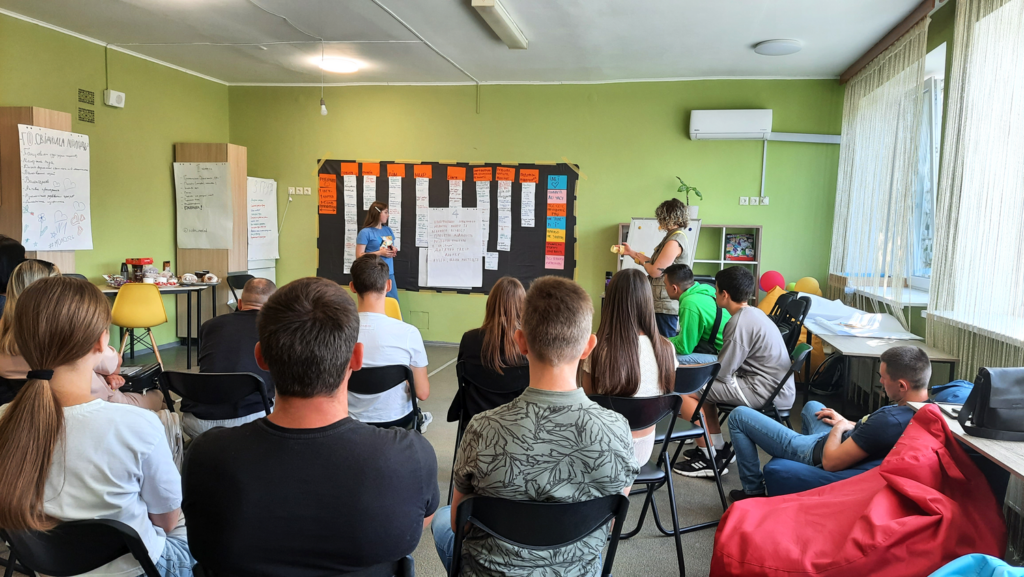
Challenges while working with the hromada
It was somewhat more difficult to work with stakeholder mapping and making a detailed list of stakeholders for the Development Strategy. There were difficulties with singling out specific groups within the hromada’s population. This situation can be overcome by increasing the focus on analyzing the groups whom the Strategy targets and working out the stakeholders separately for each section of the document.
Dunayivtsi Hromada, Khmelnytskyi Region
About the hromada
- Hromada’s type: urban
- Population: 36,941 people as of 2021
- Area: 661,17 km²
- Year of merging: 2015
The hromada includes 51 localities: the city of Dunayivtsi, which is the hromada’s administrative center, and 50 villages that are united into 27 starostates. This is one of the largest hromadas in the Khmelnytsky Region in terms of population. The hromada is agrarian, because the biggest section of its area is dedicated to agricultural lands (79.6% of the total land stocks).
Engagement request
The main request focused on engaging interested parties into the collection of suggestions during the development of the Terms of Service for the Complex Spatial Development Plan, a strategic document that combines urban planning and land management documents at the hromada’s level with determined directions for these territories’ spatial development. The Dunayivtsi Hromada began its preparations for the Complex Plan back in 2021, but they were only able to return to it in 2023 due to the full-scale invasion. While determining the final request together with a specialist from the Department for Urban Planning, Architecture, Housing, Landscaping, and Civil Defense, who was the project’s expert, the team recorded a need for help with preparations, a survey, and organization of group discussions with specific stakeholders. In addition, hromada’s representatives had limited prior experience in citizen engagement, so part of the request was also to increase their capacity to use engagement practices.
Working with the hromada
After clarifying the request, the engagement experts planned and participated in the following activities.
Analyzing the hromada’s strategic documents and determining the stakeholders. Together with specialists from the Economic Department and the Urban Planning Department, the engagement experts determined the key actors who have interest and influence in the hromada’s spatial development. The exercise of determining stakeholders allowed the experts to design a plan for further engagement of each interested party according to their level of interest and influence.
Survey. This activity involved the collection of suggestions from hromada’s residents to develop a vision of problematic aspects and strengths of the hromada, evaluate the quality of services and elements of the environment, and provide space for expressing suggestions on how to improve the environment. The survey targeted a broad group of residents who are unlikely to be able to or interested in joining lengthy discussions, but who, instead, can dedicate 15–20 minutes of their time to fill out a survey.
Expert interviews and focus group discussions. For more interested and influential actors, the engagement experts conducted a number of focus group discussions to explore their opinions and views of the hromada from the perspective of spatial development. In particular, the experts conducted an interview with the mayor on the particularities of the spatial development of the Dunayivtsi Hromada as well as three group discussions (with business representatives, civil activists, and officials from local self-government bodies) during which, in addition to collecting spatial suggestions, the team asked them about the characteristics of their work and how their work was reflected in the hromada’s space.
A strategic session became the final engagement event at the stage of preparing the PRD for the Complex Spatial Development Plan and working with the engagement experts in general. The strategic session aimed to summarize all the previous activities of collecting suggestions and to discuss the hromada’s spatial development from the sectoral perspective. The event was held in the World Cafe format on August 11, 2023, in the office of the Executive Committee in Dunayivtsi.
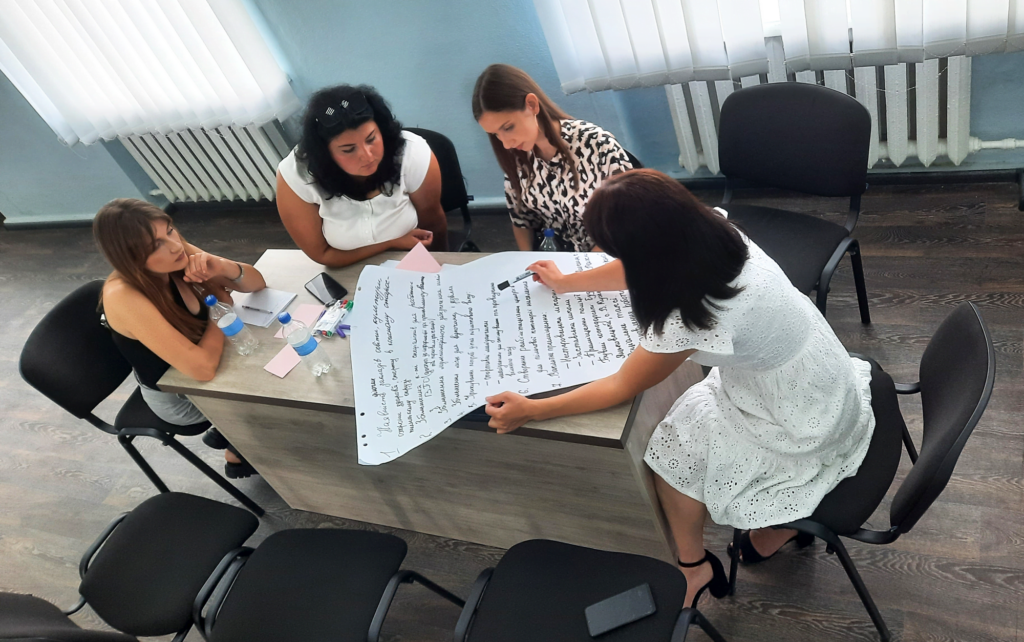
Key outcomes of working with the hromada
The strategic session brought the required number of participants to the discussion tables, which ensured a dynamic discussion. The participants moved between the tables with interest during the next rounds of the discussion, and the moderators were able to ensure equal representation of the participants at each table and monitor the timing of the discussion. The work with maps at each table was also a positive experience because it allowed the participants to immediately mark suggestions in space and in relation to other proposed suggestions. All the participants gave positive feedback about the strategic session.
Challenges while working with the hromada
- At first the project experts only planned to conduct an online survey. But at that stage, the need emerged to conduct an additional offline survey. Therefore, while conducting quantitative surveys, it is advisable to plan in advance for the possibility of distributing a paper questionnaire and to design a procedure for the distribution and digitization of the information for analysis, because in this case additional paper questionnaires were only distributed when the dynamics of responses to the online survey did not meet the targets.
- Some of the people invited to the focus group discussions were unable to attend. So in order to ensure a more active group dynamics during focus group discussions, it is advisable either to engage more participants in discussions or to invite more people than are expected to come, given that some of them will be unable to attend.
Annex 3. Questionnaire for the Dunayivtsi Hromada
Annex 4. Stakeholder mapping for the Dunayivtsi Hromada
Karlivka Hromada, Poltava Region
About the hromada
- Hromada’s type: urban
- Population: 20,292 people as of 2023
- Area: 333,9 km²
- Year of merging: 2020
The Karlivka Territorial Hromada includes the city of Karlivka, 11 villages and 5 towns. The hromada is located in the southeastern part of the Poltava Region on the right bank of the River Orchyk. The distance between the localities of the Karlivka Urban Hromada to the regional center, Poltava, varies from 16.7 km to 74.8 km.
As of 2023, about 1,500 residents of the hromada are internally displaced. The majority of the hromada’s landscape are forest-steppe plains. The hromada’s economy specializes in agriculture and industry. The hromada’s main enterprise, the Karlivka Machine Building Factory, employed over 650 people as of 2022.
Engagement request
In 2023, the Karlivka Hromada worked on the development of its Hromada’s Development Strategy for 2024–2027. The hromada was interested in the methods which could be used to engage stakeholders in developing the Hromada’s Development Strategy. In addition, the hromada sought to obtain knowledge on how the residents could be engaged in decision making processes.
Working with the hromada
The engagement experts’ work with the hromada had several stages.
Clarifying and detailing the hromada’s request, which helped determine that the hromada needed to increase its knowledge about citizen engagement in decision making processes and wanted to learn how to define and engage stakeholders in the process of creating the Hromada’s Development Strategy.
Helping the hromada with creating a questionnaire which could be used to conduct a survey of the hromada’s businesses.
A significant share of work with the hromada was done during the experts’ visit to the hromada in July 2023, when they worked with representatives of the Karlivka City Council.
The project experts conducted a training session to inform hromada’s representatives about the principles of engagement in decision making processes.
A stakeholder analysis was conducted, during which hromada’s representatives practiced determining the possible influences and interests of various actors from the hromada in the work on its development.
The key aspects of communication with some stakeholders were determined. The participants considered the particularities of working with high school students (meetings without teachers, talking as peers, creating a safe space), with IDP and young parents (in-person meetings with a space for mingling and opportunities for collective activities), and with entrepreneurs (individual in-person communication, giving reasons for the importance of participation).
Detailed plans for engaging certain stakeholders were created:
- Plan for Engaging Entrepreneurs involves the conduction of online and offline surveys as a way to reach this group;
- Plan for Engaging the Youth (high school and college students) involves the conduction of a public discussion in the World Cafe format, an event which allows the team to create an environment that facilitates discussions of the life in the hromada and the vision of its future;
- Plan for Organizing a Survey of hromada’s Residents to Collect Suggestions for the Hromada’s Development Strategy Draft involves the distribution of a questionnaire created by the project experts which will help receive feedback about the development of this strategic document.
Key outcomes of working with the hromada
The engagement experts successfully managed to:
- conduct a training session for the officials of the Karlivka City Council which improved their awareness of the importance of the participatory process and the key principles of organizing the engagement of hromada’s residents in decision making processes;
- discuss with hromada’s representatives the reasons for the challenges that existed in the hromada during the previous engagement processes and the ways to overcome these challenges;
- work with hromada’s representatives on the details of the strategies for engaging the key categories of stakeholders.
Challenges while working with the hromada
- The main engagement request which the experts were supposed to work on changed somewhat during their work with the hromada.
- The initially planned engagement goals were not achieved because of the longer process of coordinating the request with hromada’s representatives and because of limited resources for cooperation with the experts. This challenge could have been mitigated by involving more employees of the local self-government bodies in the work with participatory processes.
Kosiv Hromada, Ivano-Frankivsk Region
About the hromada
- Hromada’s type: urban
- Population: 32,281 people as of early 2022
- Area: 337 км2
- Year of merging: 2020
The hromada consists of the city of Kosiv and 14 villages around it.
The hromada is located at the foothills of the Carpathian Mountains; 12 out of its 15 localities have the mountain settlement status, which covers 86% of the hromada’s population and 88% of its area. Most of its area are forest-covered mountains, and given this landscape, the hromada does not have a lot of land.
A defining feature of the hromada is the Hutsulshchyna National Nature Park located in its territory. Its landscape and climate make the hromada attractive to tourists in all seasons for hiking, water tourism (Rybnytsia and Pistynka rivers), food tourism, and mountain tourism.
The hromada’s center is the city of Kosiv, known as the center of Hutsul art (pottery, weaving, wood carving, etc.). It is also the transit hub for the area, crossed by roads to Kolomyia, Kuty, Verkhovyna, Sniatyn. The city itself is recognized as historic and as a resort city.
Engagement request
The hromada addressed the project experts with a request for support in conducting a strategic session to collect information in order to design the Product Requirements Document for the development of its Complex Territorial Spatial Development Plan (hereafter referred to as the CP). By the beginning of the full-scale invasion, the hromada already had an approved decision to develop the CP and formed a working group, but the process was put on hold due to the war. The team of the Kosiv hromada had prior experience in organizing citizen engagement by collecting suggestions from the hromada (both online and by visiting starostate districts), and in conducting strategic sessions and receiving feedback after events.
Working with the hromada
After clarifying the request regarding the strategic session, engagement experts participated in a series of preparatory steps for this event.
At a working group meeting during a visit to the hromada in May 2023, stakeholders were determined and ways to interact with them were analyzed. In early June 2023, the team designed and launched a Google Form to collect suggestions from hromada residents. The questionnaire was based on the directions from the Hromada’s Development Strategy for 2022–2027. Thanks to this, engagement experts and LSGBs received information which they used to plan the agenda of the strategic session and the list of contacts of individuals who could potentially be engaged in discussions of the future decisions of LSGBs.
On June 30, 2023, there was a strategic session in the building of the Kosiv City Council, which was attended by 31 participants. During the event, the engagement experts supported hromada’s officials in collecting suggestions in the fields of housing construction, economy and industrial construction, tourism and preservation of cultural and historic heritage, social services and civil construction, transit and mobility, engineering and infrastructure, and landscaping and beautification.
Immediately after the event, the engagement experts collected feedback from the participants about the impressions from and quality of the organization of the strategic session using the exit ticket instrument. The guests noted a friendly atmosphere and willingness to hear various opinions among the audience.
As of October 2023, the hromada planned to approve the results of the Strategic Session and start finalizing the Product Requirements Document for municipal enterprises and looking for funding for the development of this document from different sources. The engagement experts also recommended organizing a working group with village starostas to consider the issues of hromada’s boundaries and land issues, which was later implemented.
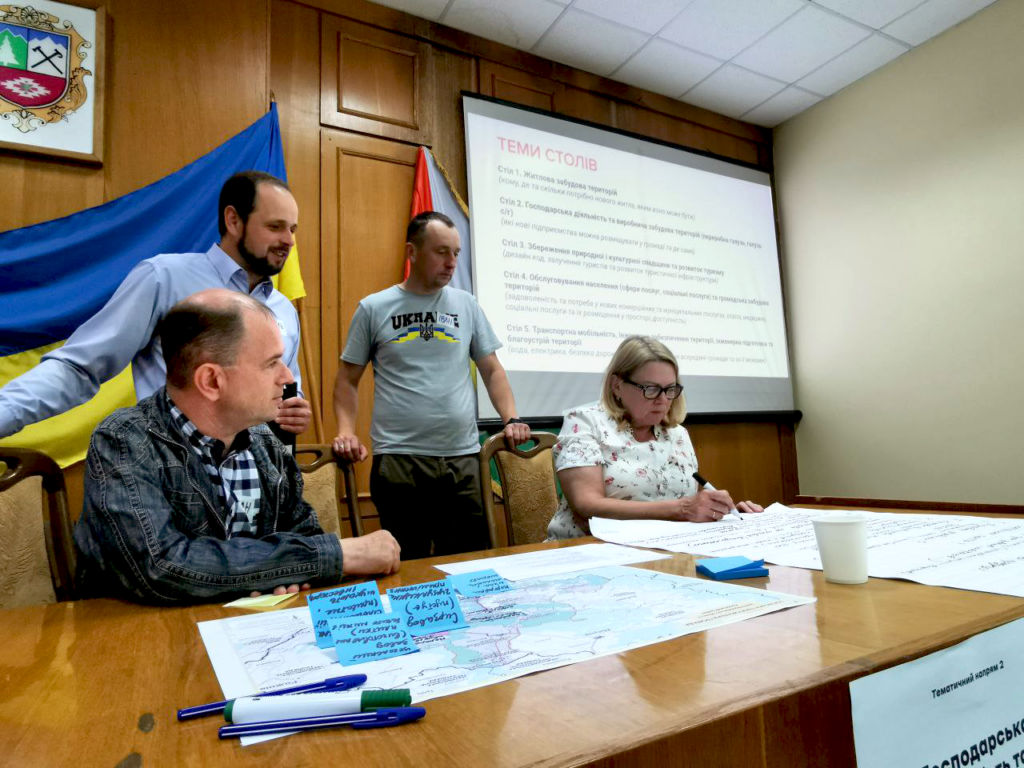
Key outcomes of working with the hromada
Communication and collaboration with the engagement experts were effective. The strategic session was organized quickly, namely in a month and a half. LSGB representatives promptly responded to the requests of the engagement experts and shared their needs. The tables during the session were moderated by officials from different city council departments, and they managed to encourage the residents (including IDPs and people with disabilities) to actively participate in the discussion.
Challenges while working with the hromada
Communication with the respondents of the Google Form who left their contacts was not organized properly. The team should have made a list of people interested in sharing their views on the hromada’s development and participating in engagement events, particularly in the strategic session. Nevertheless, the LSGBs can do this communication work later.
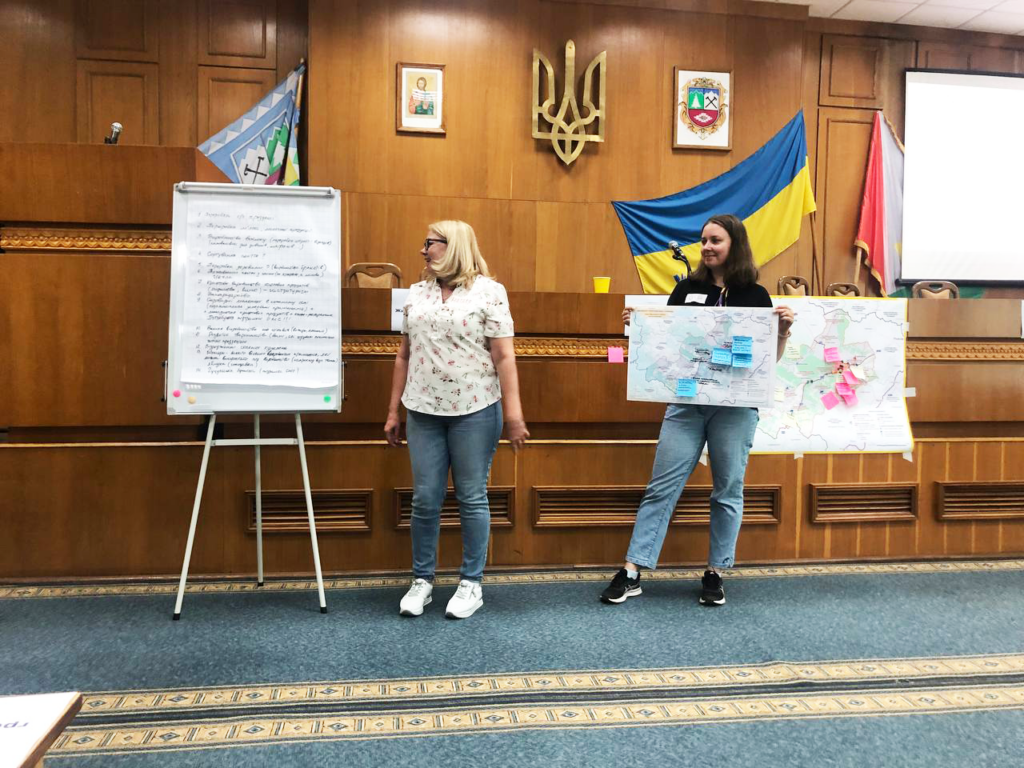
Annex 6. Senario of the strategic session for the Kosiv Hromada
Poromiv Hromada, Volyn Region
About the hromada
- Hromada’s type: rural
- Population: 6,004 people as of early 2023
- Area: 110,09 km²
- Year of merging: 2016
The hromada includes 18 villages. There are 27 industrial companies and farms in the hromada’s territory, working in the fields of crop farming, grain crop production, sugar beet farming, vegetable and berry farming, horticulture, and coal mining.
Hromada’s residents mostly work at the local mine, local farms, in the cities of Novovolynsk and Volodymyr, and abroad. The hromada has 8 secondary education institutions, 3 kindergartens, 10 medical institutions, 7 houses of culture / people’s houses, and 8 libraries.
Engagement request
The hromada’s initial request concerned the integration and engagement of IDPs. After clarifying the request, it was decided to work on the participatory planning of mobility in the hromada. Public transit is not sufficiently developed in the hromada. The means of transportation are isolated and do not form a unified system of mobility in the hromada. Therefore, the hromada faced the issue of creating a mobility program that would combine public transit development, the need to develop car traffic, bicycle traffic and pedestrian infrastructures in order to ensure high-quality mobility within the hromada.
Working with the hromada
Below are the stages of the engagement experts’ work and the instruments they used.
Pre-consultation stage (preparatory stage): at this stage, the engagement experts clarified the hromada’s request, mapped the stakeholders and designed a stakeholder engagement plan.
Consultation stage: this stage involved a survey of hromada’s residents, focus group discussions, in-depth interviews, and a strategic session.
Post-consultation stage: the final stage which consisted of the analysis of the results of the strategic session and the preparation of a report on the results of the consultations. This stage also included the work of local self-government bodies on creating a mobility and accessibility program.
As a result of this work, the hromada received: a report with a list of suggestions for the mobility and accessibility program; experience in engaging citizens in local policy development; an understanding of the possibility of effective engagement of citizens and, as a result, their high-quality suggestions.

Key outcomes of working with the hromada
- For effective engagement of residents, the team successfully conducted preparations which involved stakeholder mapping and designing a plan for working with the stakeholders.
- At the stage of consultations, all the planned events were conducted, which helped properly prepare for the strategic session and determine the directions of discussion.
- The strategic session created opportunities for effective interaction and discussion between the participants. The moderators at the tables during the World Cafe worked professionally, the process of moving between the tables was clear and well-organized, and the discussion at each table was dynamic.
- The connection of the developed ideas to the hromada’s map ensured that the suggestions were visually clear and oriented in space.
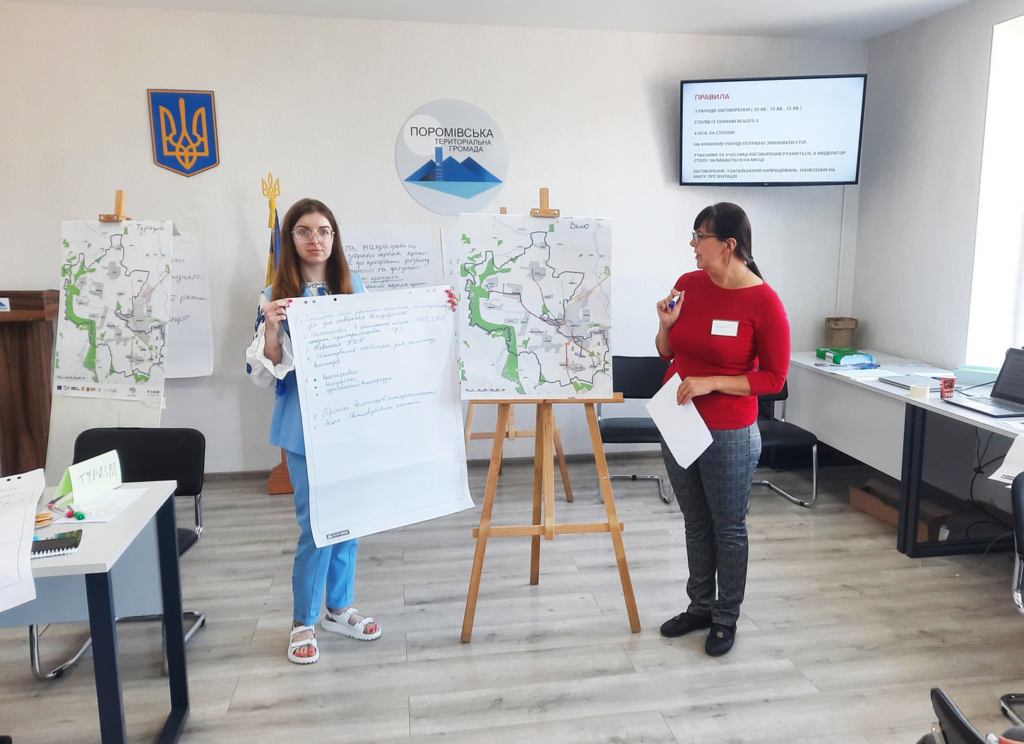
Challenges while working with the hromada
- During public consultations, it is worth taking into account the season for which they are scheduled. Due to a harvest season which coincided with the consultation events, the team was unable to engage some of the stakeholders in the activities.
- Establishing a working group tasked with developing the Mobility and Accessibility Program by a decree of the hromada’s mayor would improve its members’ engagement in the work on the program.
Annex 7. Questionnaire for the Poromiv Hromada
Romny Hromada, Sumy Region
About the hromada
- Hromada’s type: urban
- Population: 58,353 people as of 2021
- Area: 969,9 km²
- Year of merging: 2020
The hromada includes 75 localities united into 16 starostates with the city of Romny as the hromada’s administrative center. The Romny Hromada is among the largest hromadas in the Sumy Region by area, and it has the second biggest number of localities. The majority of the hromada’s population—65.6%—is urban.
The Romny Hromada has considerable mineral resources. For example, there are 5 currently exploited oil and gas deposits in the hromada’s territory, as well as 5 other oil and gas deposits which are partially located in the territories of other hromadas. The hromada is also rich in historic and natural heritage: it has the Posullia History and Culture Reserve with Cossack historic monuments as well as a group of Scythian burial mounds.
Engagement request
The hromada requested help with engaging people in the development of the Plan for the Recovery and Development of the Territorial Hromada. After a collective discussion between the project team and hromada’s representatives, it was decided to focus on supporting the hromada in organizing engagement in the development of the Product Requirements Document for the Complex Spatial Development Plan, a strategic document which combines urban planning and land management documents at the hromada’s level with defined directions of spatial development of territories. The decision to focus on the strategic document is due to the fact that the Romny Hromada is a large hromada with 75 localities which differ both in terms of standards of living and in terms of potential directions of development and problems. In addition, the development of urban planning documents requires broad engagement. So it was important for the hromada to strengthen the team for the purpose of reaching a broader audience and increasing attention to the process of developing a strategic document.
Working with the hromada
The interaction with the Romny Hromada was different due to the fact that the hromada was assisted in the development of the Product Requirements Document by the commercial organization UkrGroupProject LLC. Thus, the cooperation in the hromada took place between the team of the Cedos Think Tank, hromada’s representatives, and the team of planning experts.
The working with the hromada was divided into three stages.
Clarifying the cooperation request, meeting the involved planning organization, and distribution of tasks. At this stage, the engagement experts, hromada’s representatives, and the UkrGroupProject team divided their fields of responsibility. It was decided that support from the Cedos team was needed for the organization of public discussions in two localities and for the conduction of focus groups in three subject areas: education, culture and heritage, ecology and environment.
Examining the hromada’s strategic and spatial documents, determining the key players. These activities aimed to clarify the characteristics of the Romny Hromada and form a list of people or institutions whose opinions had to be taken into account while developing the Product Requirements Document. This stage also involved the first visit and introduction to the hromada. At a collective meeting with the working group, the main strategy of engagement as a part of the development of the PRD was determined, and the main interest groups were discussed.
Conducting focus group discussions with representatives of the fields of education and culture as well as active residents regarding environmental development. The discussions aimed to narrowly target the key problematic aspects of the hromada, its strengths, and suggestions for improvement from the spatial perspective. The focus groups involved civil activists, members of the expert community, representatives of relevant departments and offices as well as of the key institutions, local self-government bodies, and local councilors.
Conducting public discussions in the Pustoviytivka and Mali Bubny Starostate Districts in order to engage citizens to collect suggestions about their views on the development of these districts. The events were held in the World Cafe format as group discussions where the participants considered specific topics and fields in small groups while constantly moving between discussion tables. The meetings were attended by over 10 people in Mali Bubny and 15 people in Pustoviytivka. The goal of the meetings was to discuss the problems of the hromada and its specific localities, to reveal the hromada’s strengths and values, and to collect suggestions regarding development for the purpose of improving the quality of life in the fields of mobility, economy, environment, education and culture, heritage, landscaping and beautification, etc.
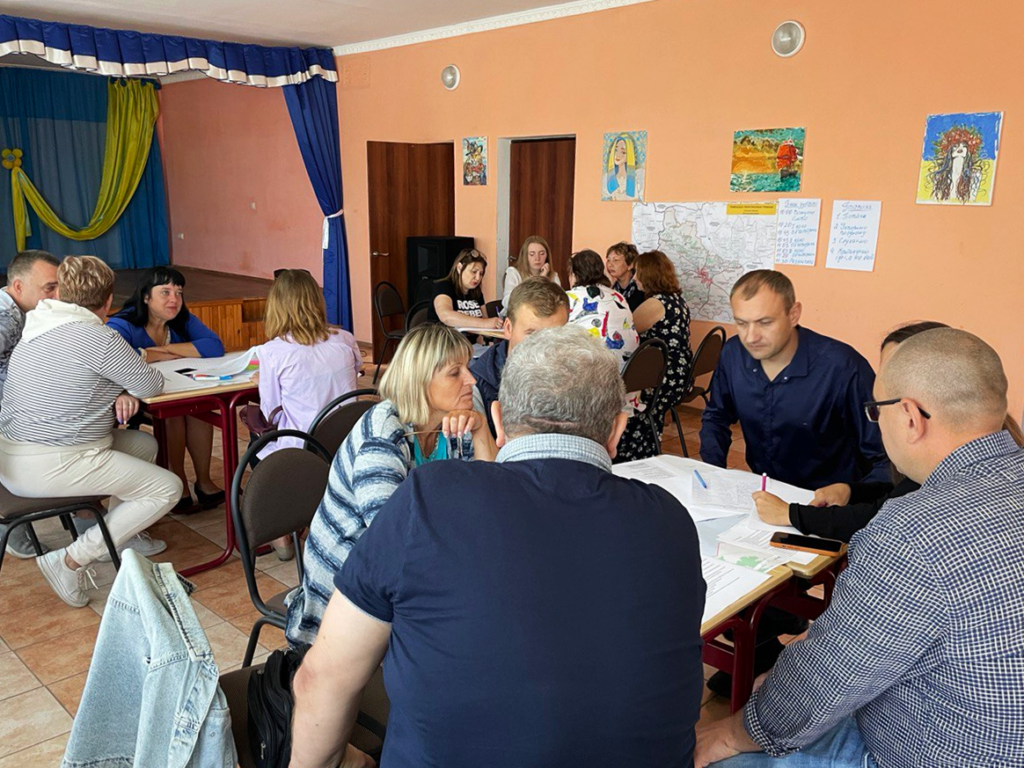
Key outcomes of working with the hromada
- The team successfully engaged residents of rural areas, particularly through starostas. This facilitated dynamic discussions at all the engagement events.
- The team successfully taught moderation skills to several specialists and active hromada’s residents. The moderators were assigned to each table during the public discussion. Before the event, they underwent a brief training in public discussion moderation. The moderator team included representatives of the departments of architecture and economy, members of the youth council, and starostas. The government representatives moderated the discussions at the table in a skilled way. The hromada’s chief architect participated in the work at the tables and helped with moderation, which significantly increased trust among the local residents and their willingness to share their ideas.
- Working with maps helped transform the participants’ opinions into specific suggestions with spatial connections.
- The focus groups involved not only representatives of the relevant departments and institutions but also local activists, members of the public council and representatives of the expert community, which helped create a discussion and ensure a more critical perspective on the hromada’s problems and ways of solving them.
- The use of informal communication channels in a messenger with the members of the working group for the development of the Complex Plan allowed the participants to solve working issues in a quick and effective way.
- Cooperation between the hromada, the team of the Cedos Think Tank and UkrGroupProject LLC helped organize in-person meetings not only in Romny but also in other starostate districts. This facilitated broader engagement in the discussion, particularly the engagement of the rural population.
- The combination of public consultations for the broader public and thematic expert meetings helped collect more complex information for the development of the PRD. The thematic meetings with representatives of the hromada (experts, activists, councilors, representatives of the relevant department) helped not only to learn about the hromada’s problems but also to discuss the visions for solving them at the expert and strategic levels. Meanwhile, the discussions with local residents in the starostate districts revealed more local problems and targeted needs.
Challenges while working with the hromada
- High-quality engagement in a hromada with a large number of localities requires a lot of meetings which are difficult to organize within a short time frame allocated for the development of a Product Requirements Document. In addition, focus group discussions involved 15 people on average, because it was important to maintain representation of different territories in the hromada. Organizing these events required the involvement of at least 6 people in the team of organizers. In order to ensure that the meetings are conducted and moderated properly, the team asked the youth council for support and they helped government representatives to moderate the event.
- The timing of the meetings coincided with the harvest. Due to employment in agriculture, a significant number of hromada’s residents were unable to participate in discussions in rural areas. It is important to pay attention to the season when consultations are held in order to involve more residents who are employed in agriculture.
- There was an air raid warning in one of the localities on the day of the meeting. This prevented residents from the neighboring locality from attending. The event was held in a building which has a bomb shelter, but the air raid warning began an hour before the appointed time of the meeting and lasted up until its beginning. The team decided to go through with the consultation. The residents who were unable to attend the event were offered to fill out written forms.
Serhiyivka Hromada, Poltava Region
About the hromada
Hromada’s type: rural
Population: 2,700 people as of 2023
Area: 167,62 km²
Year of merging: 2016
The Serhiyivka Hromada includes 13 villages. It is located in the northern part of the Poltava Region, 136 km from the city of Poltava.
As of 2023, there were 260 internally displaced people living in the hromada (10% of the hromada’s population).
The hromada’s landscape is mostly forest-steppe plains. Its economy specializes in industry and agriculture. There are mineral deposits of oil and gas in the territory of the Serhiyivka Hromada, and a group of oil and gas industrial facilities are located there.
Engagement request
The hromada has requested help with properly organizing the process of citizen engagement as a part of creating the Complex Recovery Program for the Territorial Hromada. It was important for local government representatives that residents who represent different occupations and starostates are included in the public discussions. The discussions were supposed to concern the key spheres of the hromada’s life.
Working with the hromada
The work of the engagement experts had several stages.
Clarifying the hromada’s request, determining the format of the event at which the public discussion will take place. The team chose the World Cafe format as the main instrument of engagement: during four rounds, the participants took turns to join discussion tables dedicated to business, culture, leisure, social infrastructure, and housing and utility infrastructure.
Revealing the problems and needs of hromada residents by analyzing a survey conducted by executive government bodies. The survey findings helped the local self-government bodies learn about the relevant problems and needs of the hromada’s four starostates and prioritize the implementation of several requests for infrastructural improvements, which began in summer 2023. For example, a need for updating the utility and social infrastructure in several localities was discovered, as well as a need for places where children could spend their leisure time.
Public discussion. Together with representatives of the hromada’s department of economic development and investment, the engagement experts prepared a public discussion plan. Then they collectively conducted an engagement event with the hromada’s residents. At the event, they mapped hromada problems and had a public discussion in the World Cafe format with four tables for discussing important aspects of hromada life: business, culture and leisure, social infrastructure, and housing and utility infrastructure. The event was attended by 35 people.
Analysis of the results of the public discussions by engagement experts (in cooperation with representatives of the hromada’s department of economic development and investment).
As a result of the collaboration, the executive government of the Serhiyivka Hromada had a chance to better understand the needs of the hromada’s residents and gain experience in conducting public discussions. In addition, the public discussions resulted in suggestions which are to be considered by the group working on the creation of the Complex Recovery Program.
When a draft of the Complex Recovery Program is ready, the hromada will need to organize another public discussion before it is approved. The possible formats include an offline event (presentation, Q&A, maybe also group discussion). An additional format is to publish the main slides with the goals and projects in a local group/chat and ask respondents to provide feedback within two weeks.
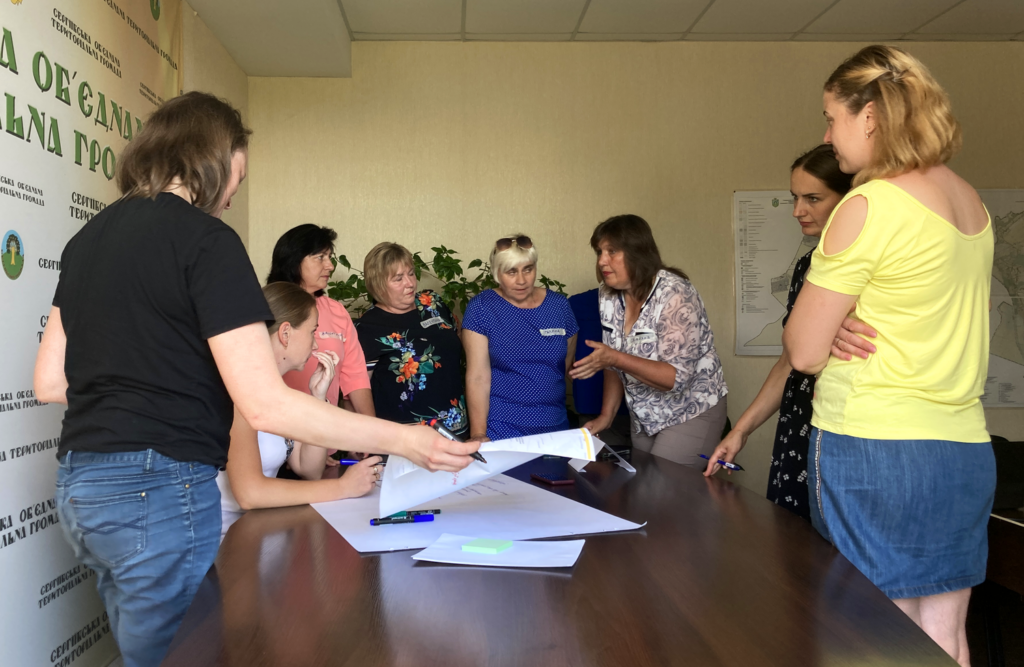
Key outcomes of working with the hromada
- As a result of the collaboration, executive government bodies of the Serhiyivka hromada gained a better understanding of the needs of hromada residents as well as experience in conducting public discussions.
- The discussion successfully engaged representatives of different professional groups (municipal workers, utility company workers, small farmers, entrepreneurs, etc.) from different starostates. They were able to constructively discuss issues from various spheres of hromada life, the hromada’s problems and prospects.
- Another result of public discussions were the articulated suggestions which were submitted for the consideration of the working group which is creating the Complex Recovery Program.
- At the public consultation in the World Cafe format, the team successfully created an informal atmosphere and facilitated an open discussion of problems and suggestions. In addition, the hromada mayor was present at the tables during the presentation of the results of the discussions; he listened closely and gave constructive comments on the suggestions of the discussion participants. In general, an atmosphere of mutual trust was achieved at the event.
Challenges while working with the hromada
- The overwhelming majority of the participants of the public discussion arrived from the central villages of the starostate districts (Serhiyivka, Rozbyshivka, Kachanovo) and worked in the public sphere. This meant that the engaged public was rather homogenous. It is worth taking into account the need to engage participants from smaller localities, as well as those whose work is not related to the public sphere.
- The event was held on the second floor of the village council building which is not accessible, and this prevented groups of people with limited mobility from participating in the discussion.
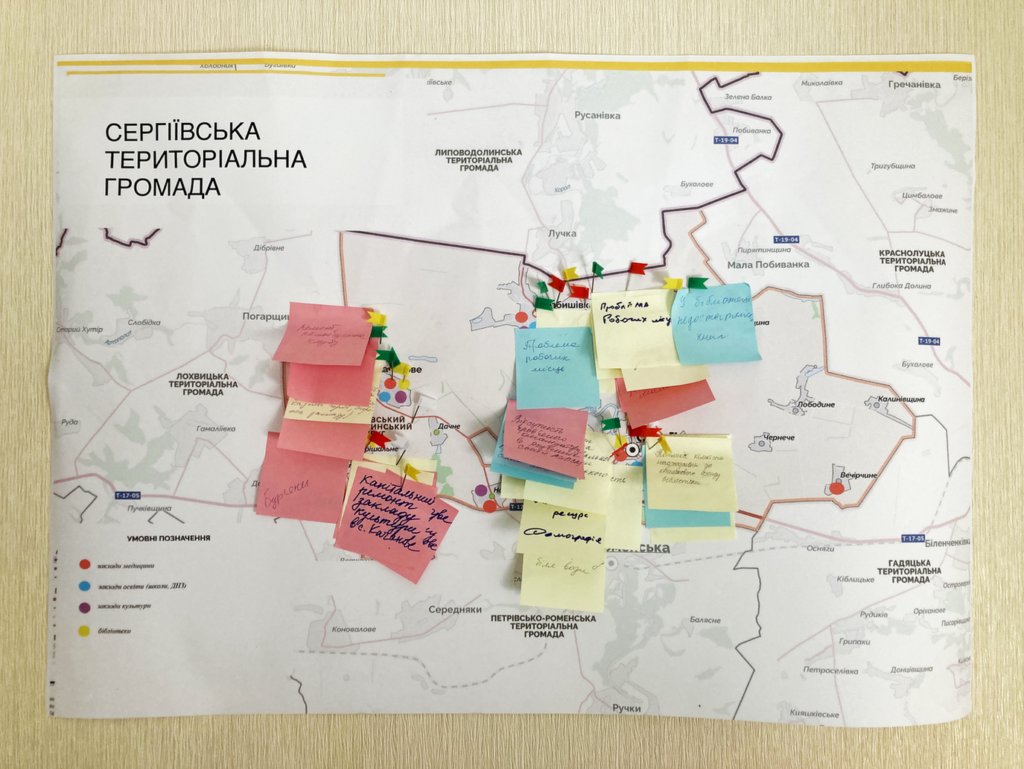
Shabo Hromada, Odesa Region
About the hromada
- Hromada’s type: rural
- Population: 13,566 people as of 2023
- Area: 580,91 km2
- Year of merging: 2017
The Shabo Hromada is a rural hromada in the Bilhorod-Dnistrovskyi District of the Odesa Region. The hromada includes 13 villages and has 23 cultural institutions (of which only 17 are operational) and 10 education institutions. A major asset of the hromada is its geographic location directly near international transit corridors and Ukraine’s main sea ports. The majority of the hromada’s businesses work in the field of agriculture and agricultural products processing. The hromada’s economic foundation and economic activities in its territory are focused both on the area’s specific features (recreation and agriculture) and on further development of a comfortable environment for tourism and life in an environmentally unpolluted area. The hromada is characterized by a high density of businesses, particularly businesses which grow and process grapes for the well-known Shabo brand. After the beginning of the full-scale invasion, tourist traffic to the hromada reduced significantly due to regular Russian bombings and due to the closure of the main railway bridge across the Dnister Lyman, which caused significant logistic difficulties.
Engagement request
The hromada requested help with organizing a youth hub or space and with optimizing its school network. During detailed conversations with hromada representatives, it was decided to focus on determining the degree of activity of the youth, particularly school children, in order to understand how to make the local youth more active and engage them in hromada life.
Working with the hromada
The work of the engagement experts with the hromada had several stages.
Clarifying and detailing the hromada’s request, namely holding online meetings to clarify the request and better understand the hromada’s context.
The first introductory trip in June 2023. During the trip, the engagement experts organized a meeting with representatives of local self-government bodies, particularly the head of the executive committee, the head of the department of education, culture, youth and sports, the main specialists of the same department, and representatives of the hromada’s education and culture institutions. The experts also mapped the stakeholders together with representatives of the local government.
A focus group discussion with teachers from the hromada’s schools regarding the interest and activation of school students as well as their engagement in hromada life.
A survey among young people aged 14 to 18 who live in the hromada regarding their leisure, places which they visit, their extracurricular activities, participation in school self-government, and willingness to participate in hromada life.
During the second trip to the hromada in August 2023, the engagement experts conducted an event for the youth. The participants of this event created mental maps of their leisure in the hromada and discussed issues such as:
- types of leisure that exist in the hromada;
- examples of public activity which the young people were familiar with;
- the spheres in the hromada which need to be improved, according to the young people;
- how the process of improvement should take place, who should be involved in it, and what resources are needed for that.
The project experts also conducted a strategic session with representatives of the fields of culture and education regarding youth engagement, where the following issues were considered:
- opportunities for the youth in the hromada;
- challenges and obstacles to making the youth more active;
- recommendations, solutions to problems;
- the hromada’s capacity to make the youth more active.
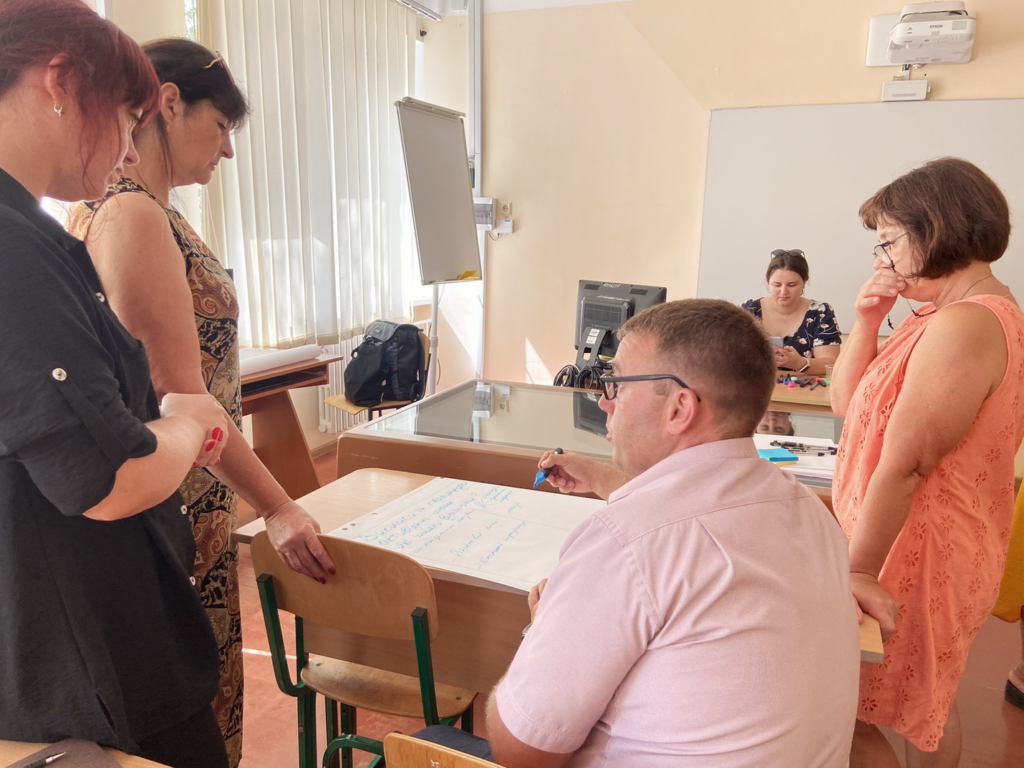
Key outcomes of working with the hromada
The project experts successfully managed to:
- go on an introductory trip and organize a meeting with some of the key stakeholders: representatives of the department of education, culture, youth and sports, representatives of culture and education institutions;
- map the stakeholders together with government representatives, determine the most interested and influential stakeholders;
- collect the responses of young people using a survey: during August-May 2023, the opinions of young people aged 14 to 18 regarding their leisure, attendance of culture institutions, degree of engagement and willingness to participate in active hromada life were collected using a questionnaire;
- conduct a focus group discussion with teachers from different schools: in August 2023, a focus group was held with teachers from different localities in the hromada which involved around 20 participants;
- conduct an offline event with young people: the event successfully engaged 16 active students who shared their thoughts about leisure and public life in the hromada;
- conduct an offline strategic session on how to make the youth more active, which involved 16 representatives of education and culture.
Challenges while working with the hromada
- Actively engage representatives of local self-government bodies to participate in important events. Local self-government representatives were unable to participate in the strategic session regarding the activation and participation of youth in hromada life. The latter requires a professional specialist in the department of education, culture, youth and sports in order to implement the youth policy.
- Collect more responses in a survey of youth, because the engagement experts were only able to obtain 30 unique responses. If surveys are conducted in the future, the hromada should work and communicate more with school representatives in order to involve more students in the survey.
- Some of the teachers who joined the focus group discussion were unable to actively participate in the conversation due to problems with internet connection and power supply in the hromada caused by Russian bombings. In the future, these factors should be taken into account and alternative options for focus group discussions should be worked out.
- Due to the period of the end of the summer break, preparations for the new school year, and difficulties in moving between the hromada’s localities due to active Russian bombing, the team was unable to engage more students of different ages and from different schools in the youth event. The hromada should communicate more with active representatives of high school and older youth using various online (website, social media, hromada’s chat bot) and offline (events) instruments.
- Between mid-July and late August 2023, the Russian army attacked the territory of the Bilhorod-Dnistrovskyi District, where the Shabo Hromada is located, almost daily. Due to the constant Russian bombing, the second trip of the engagement experts was postponed from July 2023 to late August 2023. In order to ensure the safety of the event participants, the project experts conducted the youth event in the bomb shelter of the Brytivka School, and the strategic session in the school building itself, so that they could continue working in the equipped shelter in case of an air raid warning.
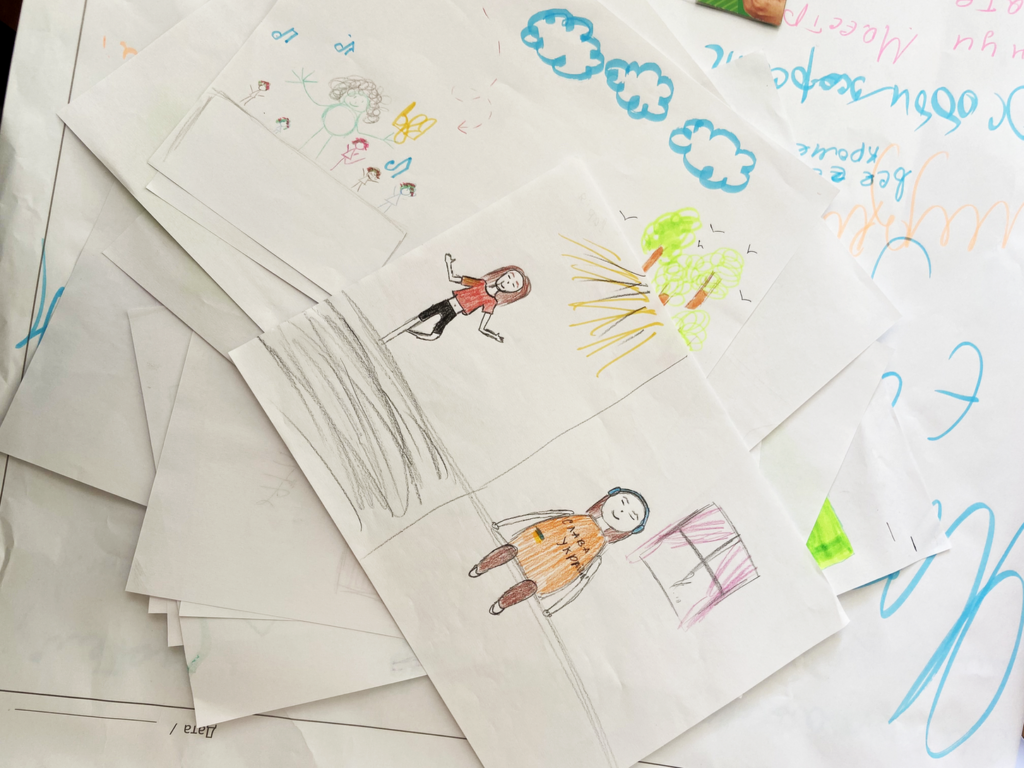
Annex 6. Questionnaire for the Shabo Hromada
Annex 7. Youth event plan for the Shabo Hromada
Conclusions
Experts who work with hromadas on engagement issues should be flexible in planning and conducting activities during the full-scale war. For example, they should be prepared to reschedule activities in case of bombings or power outages. They should also be sensitive to the life of hromadas in the conditions of bombings or tragic events. For instance, if a hromada was attacked right before a public discussion, it can be reasonable to postpone the event due to the possibility that some of the stakeholders will not be able to join. In addition, if a funeral of a local soldier killed in action is scheduled for the day of a public event in a small hromada, the team should consider postponing the event to another day.
While working with hromadas during the full-scale war, the team should focus on safety aspects, for example, by planning public events in shelters or in buildings which have shelters. At the same time, to improve the accessibility of public events and engage groups with limited mobility, events should be conducted in inclusive spaces. In addition, during a public event such as a public discussion, comfortable conditions should be created for all participants. The team can prepare coffee, tea, water, and snacks for event participants, and plan the necessary number of breaks in order to create conditions for informal discussion and networking.
Events should be conducted not only in the central locality, in order to involve residents of rural areas or remote localities in the conditions of problems with public transit. In addition, the team can arrange with local governments to use municipal vehicles in order to provide centralized transportation for residents of remote localities.
To ensure effective and high-quality engagement, several instruments should be combined, such as surveys, consultations, focus group discussions, interviews. These instruments can be used both offline and online, as well as in combination. In addition, local self-government bodies can use informal ways to inform and engage citizens in order to reach a broader audience. These can include cultural events, fairs, or festivals.
Informing hromada residents is one of the important stages of engagement. High-quality and consistent informing regarding the results of engagement and decision making can help build trust between local self-government bodies. In addition, due to the full-scale invasion, hromadas start working on new types of strategic documents, namely on complex recovery programs and recovery and development plans for their territorial hromadas. Therefore, it is important to communicate and explain the characteristics of and differences between these documents in an accessible manner. At the same time, officials from local self-government bodies should realize their responsibility before the residents whom they engage in the development of strategic documents in terms of the ability to implement the agreements that are reached. Consistent communication and informing about the stages and results of engagement will help avoid disappointment among hromada residents.
An important aspect of engagement during the war is the restoration or creation of connections and hromada support. Representatives of temporarily occupied hromadas can engage their residents by creating informal instruments of communication or through IDP councils. In addition, hromada’s members who are abroad or serving in the Armed Forces may have a need to participate in hromada life. So it is worth designing ways and instruments to engage these groups of people.
Expats and workers of local self-government bodies who organize the engagement process must be ready to adapt to the capacities of stakeholders. They should plan the instruments for reaching important stakeholders in advance. This means that some groups of stakeholders need to be contacted personally or met individually. At the same time, the team should plan and dedicate enough time to the stage of stakeholder analysis in order to design the engagement process better.
Officials from local self-government bodies and hromada residents can have less capacity to participate in active work during certain calendar periods. So seasonality should be taken into account while planning engagement activities; for example, public events should not be conducted during harvest or sowing periods or at the beginning or the end of the calendar year.
In the conditions of limited resources and capacity of local self-government bodies to independently organize participatory processes, hromadas can involve external engagement experts or ask donor organizations for help. LSGB representatives can also involve NGOs or youth councils in order to use the available resources more effectively, reduce the workload of their employees, and strengthen their team.
External experts who plan and organize the processes of engagement in hromadas should come to the specific hromada which they work with in order to personally meet the employees of local self-government bodies and deepen their knowledge about the hromada’s context. Involving external experts increases the capacities of local self-government bodies and allows them to improve their knowledge of the instruments and formats of engagement. In addition, it allows them to delegate some of their responsibilities and to conduct public engagement events with independent and impartial facilitation.
Support Cedos
During the war in Ukraine, we collect and analyse data on its impact on Ukrainian society, especially housing, education, social protection, and migration















